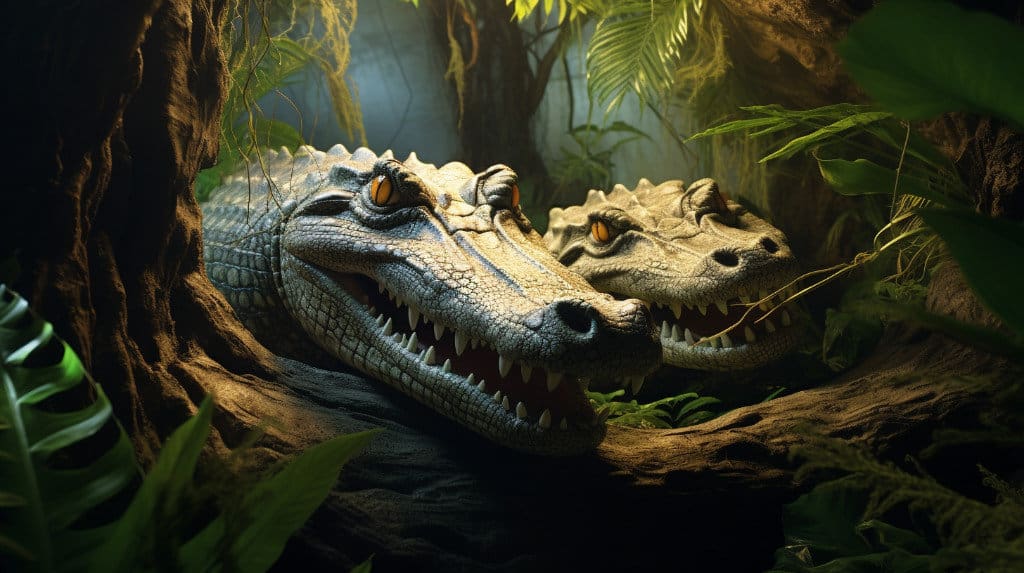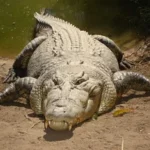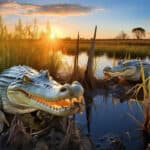Crocodiles are fearsome predators that dominate the rivers and swamps they inhabit. However, even these powerful creatures have their own predators. Crocodiles can fall victim to a variety of animals that are able to overpower them. Some of the main predators of crocodiles include larger crocodiles, big cats like lions and tigers, and large snakes such as anacondas and pythons. Additionally, humans are also a major threat to crocodiles, as they are hunted for their skin and meat. Despite their formidable reputation, crocodiles are not invincible and face constant challenges from other animals in their ecosystem.
Key Takeaways
| Predators of Crocodiles |
|---|
| Larger crocodiles |
| Lions and tigers |
| Anacondas and pythons |
| Humans |
Understanding the Crocodile’s Place in the Food Chain

Crocodiles are fascinating creatures that play a crucial role in the food chain. They are apex predators in their habitats and have a significant impact on the ecosystem they inhabit. Let’s explore the predatory nature of crocodiles and the uncommon scenario of crocodiles becoming prey.
The Predatory Nature of Crocodiles
Crocodiles are formidable predators that have adapted to thrive in aquatic environments. They are known for their stealth, patience, and powerful jaws, making them highly efficient hunters. Crocodile predators include large cats such as lions, tigers, and jaguars, as well as other carnivorous animals like pythons and herons.
When it comes to hunting, crocodiles employ various strategies depending on their size and habitat. They often lie in wait, partially submerged in water, patiently observing their surroundings. When an unsuspecting prey animal comes near the water‘s edge, the crocodile strikes with lightning speed, using its strong jaws to capture and overpower its victim. Crocodiles primarily feed on smaller prey like fish, birds, and reptiles, but they are also capable of taking down larger animals such as deer, zebras, and even elephants.
Crocodiles as Prey: An Uncommon Scenario
While crocodiles are apex predators, there are rare instances where they become prey themselves. Despite their formidable size and strength, crocodiles have natural enemies in their environment. In some cases, larger crocodile species may prey upon smaller ones, especially during territorial disputes or when resources are scarce.
One of the most surprising predators of crocodiles is the jaguar. Found in the dense rainforests of South America, jaguars are known for their strength and agility. They have been observed hunting and killing crocodiles, showcasing their dominance in the animal hierarchy.
Another unlikely predator of crocodiles is the python. These large constrictor snakes are capable of overpowering and consuming crocodiles, especially when they are young or vulnerable. This predation event is a testament to the incredible adaptability and hunting prowess of pythons.
In rare instances, crocodiles may also fall victim to larger land animals like elephants. Although these encounters are infrequent, they highlight the complex interactions within the wildlife food chain.
In conclusion, crocodiles hold a significant place in the food chain as apex predators. They play a vital role in maintaining the balance of their ecosystems. While they are formidable hunters, they are not exempt from becoming prey themselves, showcasing the intricate dynamics of the natural world.
Animals That Eat Crocodiles

Crocodiles are formidable predators, but they are not invincible. In fact, there are several animals that have been known to prey on crocodiles. Let’s explore some of these fascinating creatures and their unique hunting strategies.
Large Mammals as Predators of Crocodiles
Crocodile predators come in various shapes and sizes, and among them are large mammals. One such example is the mighty elephant. While it may seem surprising, elephants have been observed attacking and even killing crocodiles. These massive creatures possess incredible strength and intelligence, allowing them to overpower these reptilian predators.
Another formidable predator of crocodiles is the jaguar. Found primarily in the Americas, jaguars are known for their stealth and agility. They have been documented hunting and successfully taking down crocodiles, showcasing their adaptability and prowess as skilled predators.
Birds That Prey on Crocodiles
Birds, too, have their place in the crocodile‘s food chain. One such avian predator is the heron. These elegant birds are often seen wading in shallow waters, patiently waiting for an opportunity to strike. With their long beaks and sharp talons, herons can swiftly snatch small crocodiles and other aquatic prey.
Aquatic Predators of Crocodiles
In the aquatic realm, crocodiles face threats from other formidable predators. One such predator is the powerful python. These large constrictor snakes are known to ambush and overpower crocodiles, using their incredible strength to squeeze the life out of their prey. It’s a battle of strength and survival between two apex predators.
While crocodiles are known for their dominance in the water, they are not invulnerable to attacks from other aquatic creatures. Sharks, with their razor-sharp teeth and lightning-fast speed, have been known to prey on crocodiles. These encounters between two apex predators are rare but serve as a reminder of the intricate dynamics within the animal kingdom.
In the complex web of the animal hierarchy, even the mightiest predators can become prey. The natural world is full of surprises, and the interactions between crocodiles and their predators highlight the delicate balance of the wildlife food chain. From large mammals to birds and aquatic creatures, each predator plays a crucial role in maintaining the ecosystem’s harmony.
So, the next time you come across a crocodile, remember that even the most fearsome predators have their own predators to contend with. Nature’s intricate tapestry of life is a constant reminder of the fascinating and sometimes unexpected relationships between species.
Regional Variations in Crocodile Predators

What Eats Crocodiles in the African Savanna?
In the African Savanna, crocodiles face a variety of predators. One of the most formidable predators of crocodiles in this region is the large cats, such as lions and leopards. These big cats are known to occasionally prey on crocodiles, especially when they come near the water‘s edge. While crocodiles are known for their strength and powerful jaws, they can still fall victim to the stealth and agility of these feline predators.
Another predator that poses a threat to crocodiles in the African Savanna is the Nile crocodile itself. Despite being a formidable predator, adult Nile crocodiles have been known to cannibalize smaller crocodiles, including their own young. This demonstrates that even within the crocodile species, there is a hierarchical structure where larger individuals can prey upon smaller ones.
Predators of Crocodiles in the Amazon Rainforest
The Amazon Rainforest is home to a diverse range of predators that pose a threat to crocodiles. One of the most notable predators in this region is the jaguar. Jaguars are known for their strength and agility, and they have been observed hunting and killing crocodiles. These powerful felines have the ability to ambush crocodiles near the water‘s edge, using their strong jaws to deliver a fatal bite.
Another predator that preys on crocodiles in the Amazon Rainforest is the anaconda. These large snakes are known for their ability to constrict and suffocate their prey. While crocodiles are generally too large for an anaconda to overpower, there have been instances where smaller crocodiles, particularly juveniles, have fallen victim to these powerful serpents.
Crocodile Predators in the Australian Outback
In the Australian Outback, crocodiles face a unique set of predators. One of the main threats to crocodiles in this region is the saltwater crocodile, also known as the “salty.” These large and aggressive crocodiles are known to be cannibalistic, with larger individuals preying on smaller ones. This demonstrates that even within the same species, crocodiles can be both predators and prey.
Another predator that poses a threat to crocodiles in the Australian Outback is the dingo. Dingoes are wild dogs that are known to scavenge on carrion, including dead crocodiles. While dingoes may not actively hunt and kill crocodiles, they can still take advantage of a carcass if the opportunity arises.
The Predatory Chain of Crocodiles in the Sahara Desert
In the harsh environment of the Sahara Desert, crocodiles face a challenging existence. While the Sahara Desert is not typically known for its crocodile population, there have been instances where crocodiles have been found in oasis and water bodies within the desert. In these isolated pockets of water, crocodiles face a limited number of predators.
One of the potential predators of crocodiles in the Sahara Desert is the Nile monitor lizard. These large lizards are known to be opportunistic predators, and they may prey on small crocodiles if given the chance. However, due to the scarcity of water and the harsh conditions of the desert, the number of predators that pose a significant threat to crocodiles in this region is relatively low.
Overall, crocodiles face a range of predators in different regions around the world. From large cats in the African Savanna to jaguars in the Amazon Rainforest, these apex predators must navigate a complex web of predator-prey relationships to survive. Understanding the regional variations in crocodile predators provides valuable insights into the intricate dynamics of the animal kingdom.
The Human Factor: Crocodile Hunting and Consumption
Crocodiles have long been fascinating creatures, both feared and admired for their powerful presence and ancient lineage. In this article, we will explore the human factor in crocodile hunting and consumption, delving into the history of human interaction with these formidable reptiles and the countries where crocodile meat is consumed.
The History of Human Crocodile Hunting
Crocodile hunting has a rich history that dates back centuries. In many cultures, crocodiles were seen as a threat to human life and livelihoods, leading to the development of hunting practices to control their populations. Crocodile predators, such as large cats, have been known to engage in fierce battles with these reptiles, highlighting the complex dynamics of the animal kingdom.
What animals eat crocodiles? Well, crocodile natural enemies vary depending on the region and the crocodile species. In the Nile, for example, crocodile predators include large cats like lions and tigers, as well as other formidable creatures like elephants and pythons. These animals are part of the intricate crocodile food chain, where each species plays a crucial role in maintaining the delicate balance of the ecosystem.
Countries Where Crocodile Meat is Consumed
Crocodile meat, once considered a delicacy in certain cultures, is still consumed in several countries around the world. Let’s take a closer look at some of these countries and their relationship with crocodile consumption:
Australia: As the home to the largest population of saltwater crocodiles, Australia has a thriving crocodile farming industry. Crocodile meat is commonly found on menus in restaurants and is enjoyed by locals and tourists alike.
South Africa: With its diverse wildlife and rich natural habitats, South Africa has embraced crocodile farming as a sustainable way to meet the demand for crocodile meat. The country has strict regulations in place to ensure the ethical treatment of these reptiles.
Thailand: Crocodile meat is a popular ingredient in Thai cuisine, particularly in dishes like green curry and stir-fries. Thailand has a well-established crocodile farming industry that caters to both domestic consumption and export.
Mexico: In certain regions of Mexico, crocodile meat is considered a traditional delicacy. It is often prepared in stews or grilled and served as a main course. Crocodile farming has also gained traction in the country, providing a sustainable source of meat.
Papua New Guinea: Crocodile meat holds cultural significance in Papua New Guinea, where it is consumed during special occasions and ceremonies. The country has a strong tradition of crocodile hunting and sustainable use of their resources.
It is important to note that while crocodile hunting and consumption exist in these countries, efforts are being made to ensure the sustainability of these practices. Strict regulations and conservation initiatives aim to protect crocodile populations and their habitats, promoting responsible hunting and farming methods.
In conclusion, the human factor in crocodile hunting and consumption is a complex and multifaceted topic. Understanding the history of human interaction with crocodiles and the countries where crocodile meat is consumed provides valuable insights into the intricate dynamics of our relationship with these remarkable creatures.
The Impact of Predation on Crocodile Populations
Predation plays a crucial role in regulating the population of crocodiles. These apex predators have their own predators, and the dynamics of this predator-prey relationship have a significant impact on crocodile populations. Let’s explore the role of predation in regulating crocodile numbers and the effect of human hunting on crocodile populations.
The Role of Predation in Regulating Crocodile Numbers
Crocodile predators are diverse and can include large cats such as lions, tigers, and jaguars, as well as other animals like pythons, elephants, and herons. The crocodile’s position in the food chain determines its natural enemies. While crocodiles are formidable predators themselves, they are not invincible.
Crocodiles have a varied diet, and their prey can range from smaller animals like fish and birds to larger mammals like deer and even other crocodiles. However, they are not at the top of the food chain and can fall victim to larger and more powerful predators.
For example, a crocodile may become prey to a python if it ventures too close to the snake’s territory. Similarly, a baby crocodile may be attacked and eaten by a jaguar or a tiger. Even elephants, with their size and strength, can pose a threat to crocodiles if they come into close proximity.
The predator-prey relationship between crocodiles and their natural enemies helps maintain a balance in the ecosystem. It ensures that crocodile populations do not become too dominant and helps regulate their numbers within a given habitat.
The Effect of Human Hunting on Crocodile Populations
Apart from natural predation, human hunting has also had a significant impact on crocodile populations. Historically, crocodiles have been hunted for their valuable skins, which are used to make leather goods. This hunting, coupled with habitat loss, has led to a decline in crocodile populations in certain regions.
However, in recent years, conservation efforts and stricter regulations have helped protect crocodile populations from excessive hunting. Many countries have implemented laws to control hunting and trade of crocodile products, ensuring the survival and recovery of these magnificent creatures.
It is important to strike a balance between human activities and the conservation of crocodile populations. By understanding the impact of predation and human hunting, we can work towards maintaining a healthy environment for these fascinating reptiles and the entire ecosystem they inhabit.
In conclusion, predation plays a vital role in regulating crocodile populations. The predator-prey relationship between crocodiles and their natural enemies helps maintain a balance in the ecosystem. Additionally, human hunting has had a significant impact on crocodile populations, but conservation efforts have helped protect and preserve these magnificent creatures. By understanding these dynamics, we can ensure the survival and well-being of crocodiles in their natural habitats.
Conclusion
In conclusion, crocodiles are formidable predators that are rarely preyed upon by other animals. Their size, strength, and armored bodies make them highly efficient hunters. However, despite their dominance in the animal kingdom, crocodiles do have a few natural enemies. Large predators such as lions, tigers, and jaguars have been known to attack and kill crocodiles, especially when they are vulnerable during their nesting period. Additionally, humans pose a significant threat to crocodiles through hunting and habitat destruction. Overall, while crocodiles may have a few predators, they remain one of the most powerful and fearsome creatures in the animal kingdom.
Frequently Asked Questions
1. What animal eats crocodiles in the wild?
Large cats such as lions and tigers, as well as other predators like the Nile crocodile, have been known to prey on smaller or younger crocodiles. It’s important to note that this is not common, as crocodiles are apex predators themselves.
2. What do crocodiles eat in Dreamlight Valley?
Crocodiles are carnivorous animals and their diet typically includes fish, birds, mammals, and other reptiles. Specific prey may vary based on the crocodile‘s size and available food sources in Dreamlight Valley.
3. What eats crocodiles in the Amazon Rainforest?
In the Amazon Rainforest, the main threat to crocodiles is the jaguar. Jaguars are known to hunt and eat crocodiles, taking advantage of their terrestrial and aquatic capabilities.
4. How do crocodiles eat their prey?
Crocodiles use their powerful jaws to grab and hold onto their prey. They cannot chew, so they tear off chunks of flesh and swallow them whole. If the prey is large, they will perform a ‘death roll‘ to tear off manageable pieces.
5. What crocodiles eat humans?
While crocodile attacks on humans are relatively rare, the Nile and Saltwater crocodiles are the most likely species to pose a threat to humans, due to their size and aggression.
6. What animal eats crocodiles in the Sahara Desert?
Crocodiles are not typically found in the Sahara Desert due to its harsh, arid environment. However, in regions where crocodiles do exist, large cats like lions could potentially prey on them.
7. What eats crocodiles in the Great Barrier Reef?
In the Great Barrier Reef, larger sharks, such as the Tiger Shark or the Great White Shark, can pose a threat to crocodiles, especially to the smaller or younger ones.
8. What do crocodiles eat in the African Savanna?
In the African Savanna, crocodiles feed on a variety of prey including fish, birds, and mammals such as antelope, zebras, or even young hippos when available.
9. What birds eat crocodiles?
No bird species is known to actively hunt and eat crocodiles. However, large birds of prey may take advantage of young or small crocodiles if the opportunity arises.
10. What country eats crocodile meat?
Crocodile meat is eaten in various countries across the world, including Australia, parts of Asia like the Philippines and China, and in some regions of Africa. It is considered a delicacy and is often used in soups, stews and grills.




